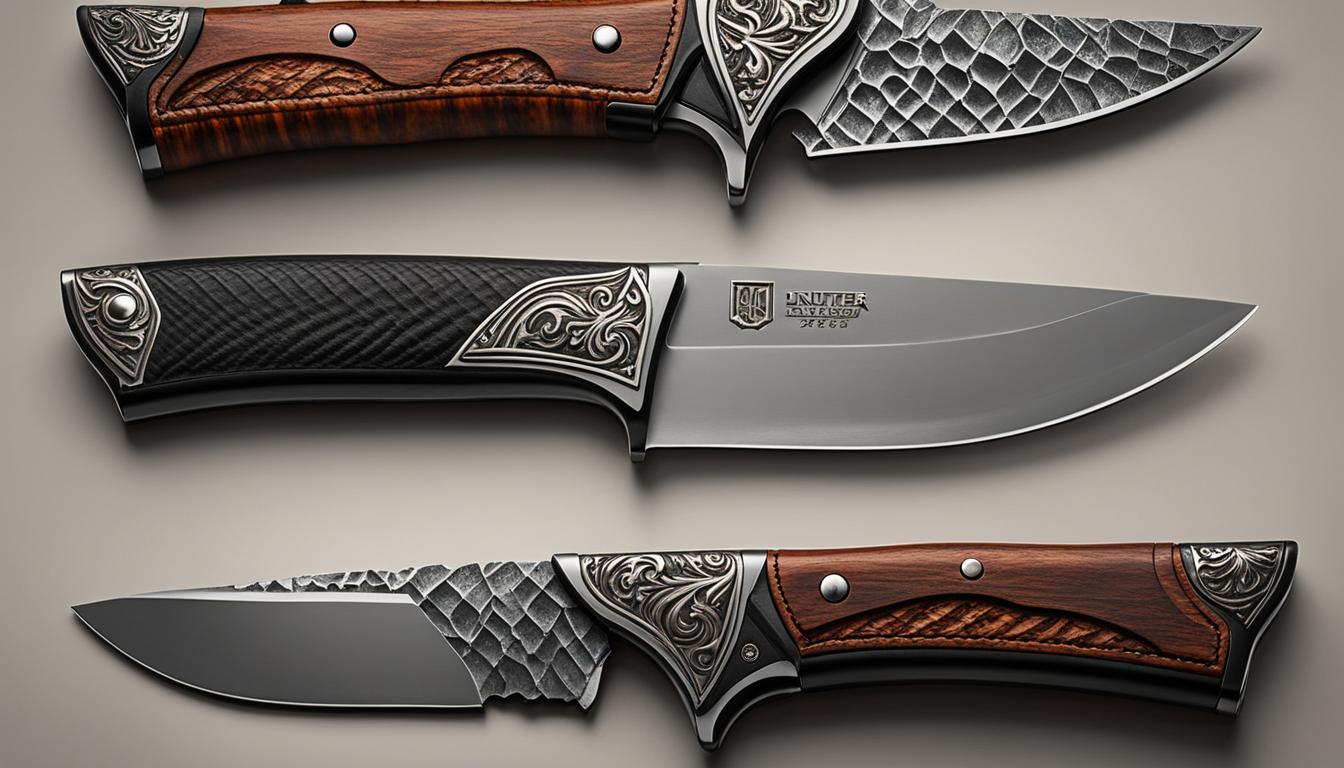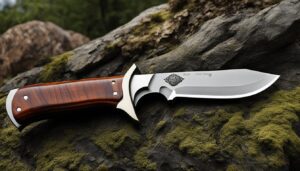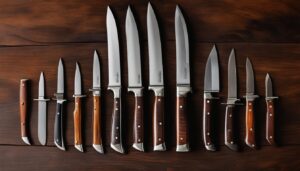Hunting knives are essential outdoor equipment that offers usability, adaptability, and dependability. Whether I am an experienced hunter or a novice exploring the great outdoors, having a high-quality hunting knife is necessary for a variety of tasks like skinning, cutting, and even self-defense. In this guide, I will explore the criteria for selecting the best stainless steel hunting knife and provide tips for maintaining its longevity.
Key Takeaways:
- Choosing the right hunting knife involves considering factors such as blade type, type of steel, knife handle, tang, and sheath.
- Hunting knife blades come in various types, including drop point, clip point, gut hook, Bowie, and trailing point.
- Materials for hunting knife blades include stainless steel and carbon steel, while handle options range from wood and rubber to synthetic materials.
- Proper maintenance of stainless steel hunting knives is crucial for their longevity and performance.
- Stainless steel hunting knives provide durability, sharpness, and corrosion resistance for various hunting tasks.
Criteria for Choosing the Right Hunting Knife
When it comes to selecting a hunting knife, there are several important criteria that should be considered. These factors will ensure that you choose a knife that is well-suited for your specific needs and preferences. Let’s take a closer look at the key elements that should be taken into account when choosing a hunting knife.
Blade Type
The shape and type of the blade are crucial considerations when selecting a hunting knife. Two popular blade shapes are the drop point and clip point. The drop point blade is versatile and suitable for a wide range of hunting tasks, making it a popular choice among hunters. On the other hand, the clip point blade is known for its fine and sharp point, making it ideal for tasks that require precision and piercing.
Type of Steel
The type of steel used for the blade is another important factor to consider. Stainless steel and carbon steel are the most common options. Stainless steel blades are highly resistant to corrosion, making them ideal for hunting in wet and humid conditions. Carbon steel blades, on the other hand, offer excellent edge retention and are easier to sharpen. They can provide superior cutting performance but require more maintenance to prevent rust.
Knife Handle
The handle of the hunting knife plays a crucial role in providing a secure and comfortable grip. It should be ergonomically designed for ease of use and minimize the risk of slippage. Popular handle materials include wood, rubber, and synthetic options. Wood handles offer a traditional and aesthetic appeal, but may require more maintenance. Rubber handles provide excellent grip even in wet conditions, while synthetic handles are known for their durability and resistance to environmental elements.
Tang and Sheath
The tang of a hunting knife refers to how far the blade extends into the handle. Full tang knives are considered to be stronger and more durable, as the blade extends through the full length of the handle. Partial tang knives have the blade extending partially into the handle, making them lighter but potentially less robust. Additionally, the sheath is an important accessory that should be sturdy and reliable for safe storage and transportation of the knife.
By considering these criteria, you can make an informed decision when choosing a hunting knife that meets your needs and preferences. It’s important to find a balance between the blade type, type of steel, handle material, tang, and sheath to ensure that you have a reliable and durable hunting knife that will serve you well in the great outdoors.
| Criteria | Options |
|---|---|
| Blade Type | Drop point, Clip point |
| Type of Steel | Stainless steel, Carbon steel |
| Knife Handle | Wood, Rubber, Synthetic |
| Tang | Full tang, Partial tang |
Types of Hunting Knife Blades
When it comes to selecting a hunting knife, the type of blade plays a crucial role in determining its functionality and versatility. Here are some common types of hunting knife blades:
Drop Point Blade
The drop point blade is a popular choice among hunters due to its versatility and durability. The blade has a convex curve and a sharp, strong point, making it suitable for various tasks, including skinning and general-purpose cutting. The gradual slope of the blade’s spine also provides excellent control and precision.
Clip Point Blade
The clip point blade is characterized by a concave curve on the spine, which leads to a sharp, fine point. This type of blade is ideal for detailed work and piercing tasks. With its ability to make precise cuts, the clip point blade is often favored by hunters who require accuracy in their hunting activities.
Gut Hook Blade
The gut hook blade features a small, sharpened, semi-circular hook on the spine near the point of the blade. This unique design allows hunters to make clean and easy cuts when field dressing game animals without puncturing internal organs. The gut hook blade is specifically designed for this purpose, making it an essential tool for hunters.
Bowie Blade
The Bowie blade, named after the legendary Jim Bowie, is a robust and versatile blade with a characteristic clip point and a long, curved edge. This blade design excels in slicing and chopping tasks, making it suitable for both hunting and self-defense situations. The Bowie blade offers excellent cutting performance and durability, making it a popular choice among hunters.
Trailing Point Blade
The trailing point blade is characterized by a pronounced, upward-curving edge, which makes it ideal for skinning and slicing tasks. This blade design allows for easy maneuverability and precise cuts, making it a suitable option for hunters who frequently engage in skinning game animals.
Materials and Handle Options
When it comes to choosing a hunting knife, the materials used for the blade and the handle are crucial considerations. Let’s explore the options for both.
Blade Materials:
Two popular choices for hunting knife blades are stainless steel and carbon steel. Stainless steel blades are known for their excellent resistance to corrosion, making them ideal for use in wet and humid environments. They also require less maintenance compared to carbon steel blades. On the other hand, carbon steel blades offer superior edge retention, making them a preferred choice for those who prioritize sharpness and durability.
Handle Options:
The handle of a hunting knife plays a significant role in the overall comfort and functionality of the knife. Here are some different handle materials to consider:
- Wood handle: Wood handles provide a traditional and natural look and feel. They often offer a warm and comfortable grip, making them an attractive choice for many hunters.
- Rubber handle: Rubber handles are designed to provide exceptional grip, even in wet conditions. They offer excellent slip resistance and can provide a secure hold, ensuring precise control during use.
- Synthetic handle: Synthetic handles, often made from materials like plastic or composites, are known for their durability and resistance to the elements. They are a popular choice for those who require a rugged and long-lasting hunting knife.
When selecting a hunting knife, it’s important to consider your personal preferences and the specific requirements of your hunting activities. The choice between stainless steel and carbon steel blades, as well as the handle material, can greatly impact the performance and longevity of your knife. Take the time to assess your needs and find the combination that best suits your hunting style.
Conclusion
After considering the criteria for choosing the right hunting knife and exploring the different blade types and handle options, it is clear that stainless steel hunting knives are a top choice for outdoor enthusiasts. With their durability, sharpness, and resistance to corrosion, these knives are designed to withstand the demands of hunting tasks.
By selecting a stainless steel hunting knife that suits your specific needs and maintaining it properly, you can ensure a reliable and long-lasting tool for your outdoor adventures. Remember to choose a blade type that matches the tasks you’ll be performing, and consider the handle material that provides the best grip and comfort for you.
Whether you are an experienced hunter or a novice exploring the great outdoors, a stainless steel hunting knife is an indispensable tool. Its versatility and dependability make it essential for a wide range of tasks such as skinning, cutting, and self-defense. So, invest in a high-quality stainless steel hunting knife and gear up for your next hunting expedition with confidence.
FAQ
What factors should I consider when choosing a hunting knife?
When choosing a hunting knife, you should consider the shape and type of the blade, the type of steel used for the blade, the handle of the knife, the tang, and the sheath.
What are the different types of hunting knife blades?
Hunting knife blades come in various types such as drop point blade, clip point blade, gut hook blade, Bowie blade, and trailing point blade.
What are the advantages of stainless steel and carbon steel blades?
Stainless steel blades are more resistant to corrosion, while carbon steel blades offer better edge retention.
What are the popular handle options for hunting knives?
Popular options for handle materials include wood, rubber, and synthetic materials like plastic or composites.
How do I select the right stainless steel hunting knife for my needs?
The right stainless steel hunting knife depends on factors such as blade type, handle material, and overall quality. Consider your specific hunting needs and choose accordingly.
How can I maintain the longevity of my stainless steel hunting knife?
Proper maintenance involves cleaning and drying the knife after each use, oiling the blade regularly, and storing it in a safe and dry place.





